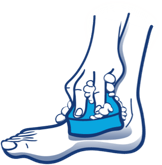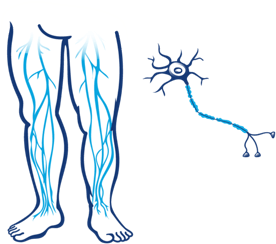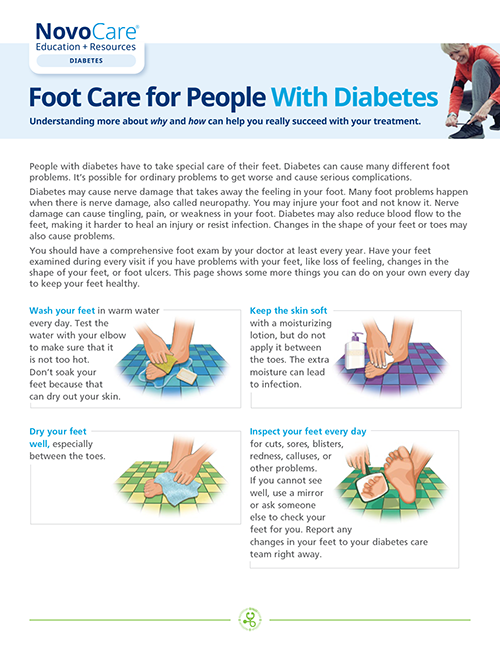
STAYING ON TRACK
Managing the risk of long‑term problems

Now is the time to take action to help reduce the risk of long‑term problems from diabetes.
You probably know that diabetes can be rough on your body. But many signs of the damage diabetes can cause may not show up for several years. Even then, the signs may be so small that you don’t notice them. That’s why it’s important to know what you can do right now to help keep track of and reduce long‑term problems.
1. Keep things healthy.
Healthy lifestyle habits are important for everyone. And living with diabetes, you may find it especially helpful.
And living with diabetes, it's especially important to remember these aspects of diabetes care:
2. Take the tests.
The lab tests that your diabetes care teamDiabetes care teamYour diabetes care team may include a primary care doctor, a diabetes and hormone doctor (endocrinologist), a registered nurse, a diabetes educator, a dietitian, a heart doctor (cardiologist), a foot doctor (podiatrist), an eye doctor (ophthalmologist/optometrist), a kidney doctor (nephrologist), a dentist, a pharmacist, and a mental health professional. may require can help show if diabetes has caused any health problems.
3. Keep an eye on blood glucose.
This is a big part of diabetes care because over time, high blood glucose (hyperglycemia) can lead to some serious problems. If it’s not controlled, high blood glucose can affect many different parts of the body.
The American Diabetes Association (ADA) has made a list of some common problems. Below, you can find helpful descriptions of each and ways to reduce your risk.
Pay special attention to your feet. Nerve damage and poor circulation can cause problems.
Nerve damage can prevent someone from feeling pain, heat, or cold.
So, if a sore or cut develops, it may not be felt, in which case it might not be treated. As a result, it can get worse and become infected.
Peripheral vascular disease can reduce blood flow to the feet so infections may not heal.
People with diabetes can help protect their feet with these care tips:

- Get a complete foot exam each year—more often if you have foot problems.
- Wash feet every day. Use warm, soapy water and dry them well.
- After washing, moisturize your feet with lotion to keep the skin healthy

- Do not go barefoot, even indoors.
- Make sure shoes and socks fit well.
- Check feet every day, looking for cuts, bruises, or swelling.
- If feet are injured in any way, call the diabetes care team
- If you have corns, calluses, or ingrown toenails, see a foot doctor (podiatrist)

- Take care of toenails—use a nail file to file your toenails down.
- Avoid using clippers because you could cut yourself
- If you do get a cut or a scratch, care for it right away
- At each medical visit, make sure that feet are checked.
- As a reminder, remember to take off socks and shoes before the examination
The body’s nerves are like wires that send signals to and from your brain.
Over time, high blood glucose can damage the nerves in your body. This damage is called neuropathy.
It is not completely clear why this happens. But people who have had diabetes for a long time are more likely to have some nerve damage.

Some of the symptoms of nerve damage may include:
- Burning, numbness, or pain in the hands or feet
- Loss of bladder or bowel control
- Trouble digesting food
- Sexual problems
- Muscle weakness
- Lack of strength
- Loss of feeling
These symptoms may come and go and may feel worse at certain times.
But they can also be caused by other health problems. Be sure to talk with the diabetes care team if you, or your loved one with diabetes are having any of them.
Some ways to help reduce the risk of nerve damage are:
- Keep blood glucose as close as possible to target
- Avoid alcohol
- If you, or the person you care for, haven't done so already, stop smoking
- Be physically active
High blood glucose can damage the tiny vessels that bring blood to your eyes. This damage can lead to a variety of problems, including loss of vision.

Eye problems, like many other problems of diabetes, don't have to happen.
Taking these steps may help to protect the eyes:
- Keeping blood glucose within the target range set by the diabetes care team
- Keeping blood pressure within the target range set by the diabetes care team
- Once a year, getting an eye exam where the eye doctor widens (dilates) the pupils to look for problems inside of the eye
- If you, or the person you care for, notice blurry vision or little specks floating before your (or their) eyes, call the diabetes care team right away
The kidneys filter waste products out of the blood. When it is not treated, over time, high blood glucose can damage the small blood vessels in the kidneys. This damage forces the kidneys to work too hard to filter blood. After many years, the extra work can make the kidneys fail.

Here’s what you can do to care for your kidneys:
- Keep blood glucose and blood pressure in check—as close as possible to the target range set by the diabetes care team
- Urine tests. Have a urine test for protein each year (a urinary albumin test). It can help find kidney damage in its early stages, before it gets worse
- Blood tests. Have a blood test for serum creatinine at least once a year. This test can also find kidney damage in its early stages
- Quit smoking. Smoking raises the risk of damage to small blood vessels
Vascular disease can cause damage to the different blood vessels in your body. Oxygen, glucose, nutrients, and other substances travel through our blood vessels to reach the different parts of the body, and a blockage leads to problems.
In peripheral arterial disease (PAD), blocked arteries interrupt blood flow to the legs and can cause these sensations in the legs and feet:
- Cramps
- Aches
- Burning
People with diabetes are 2 to 4 times more likely to have vascular disease than people without diabetes. The ADA suggests protecting against vascular disease by following these steps:
- Quit smoking
- Lower bad cholesterol (LDL) and raise good cholesterol (HDL)
- Lower high blood pressure
- Increase physical activity
- Ask your doctor about proper care and treatment
One area of the body that people don’t often think about when it comes to diabetes is the mouth.

Diabetes can cause oral health problems. That’s because high blood glucose can add more sugar to saliva, which can help harmful bacteria to grow.
Problems may include:
- Gum infections/disease
- Poor healing
- Tooth decay/loss
- Thrush (a fungal infection)
The dangers of gum disease
Of all the oral problems that can be caused by diabetes, gum disease is perhaps the most dangerous. Why? People with diabetes are more vulnerable to bacterial infections. Once an infection is present, it can be harder to treat in people who have diabetes.
How to protect your teeth and gums:
- See your dentist at least 2 times a year for checkups and cleanings. Be sure to tell your dentist that you have diabetes
- If gums are bleeding, red, or tender, and it lasts more than a few days, call the dentist. This could be a sign of gum disease
- Brush your teeth 2 times a day—and floss once a day
- Stop smoking



